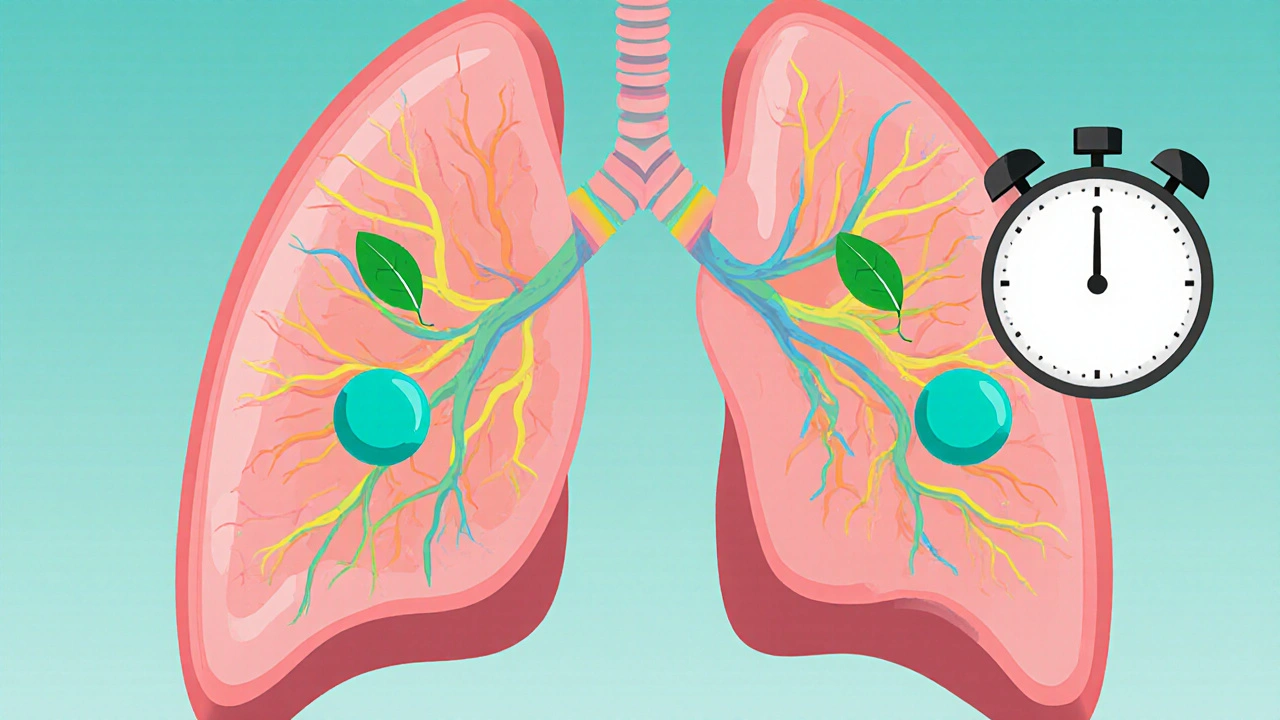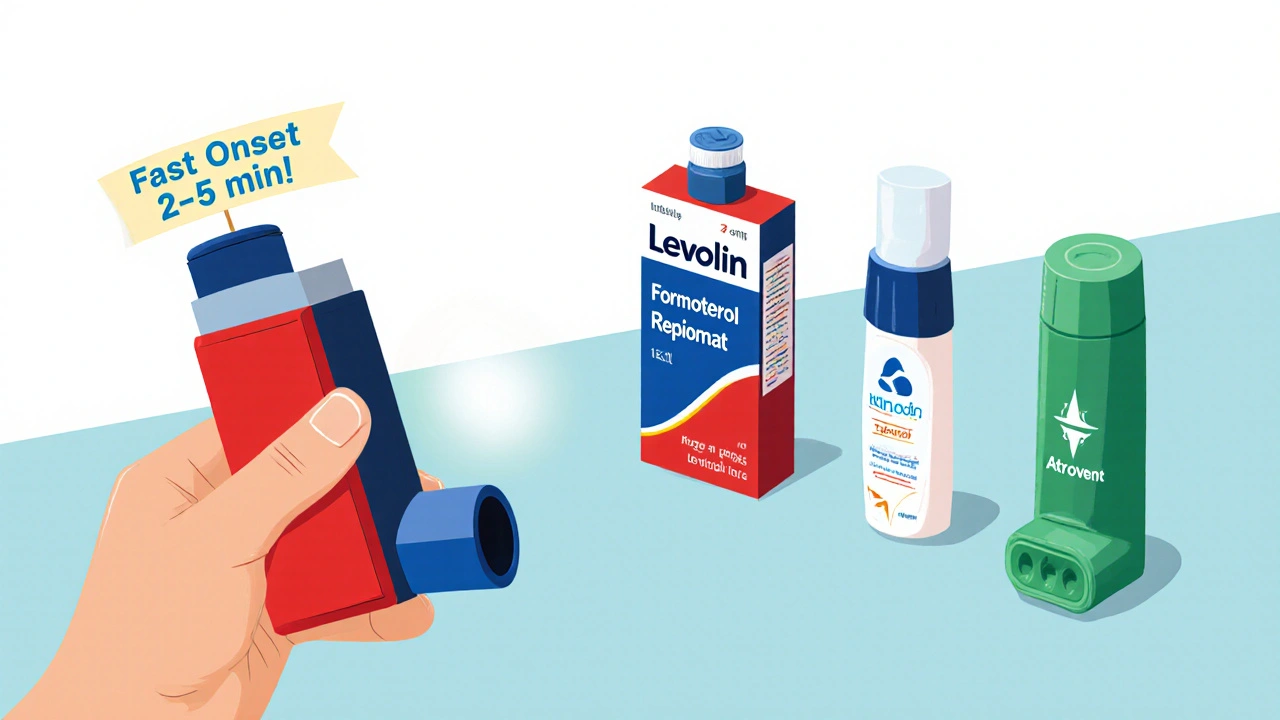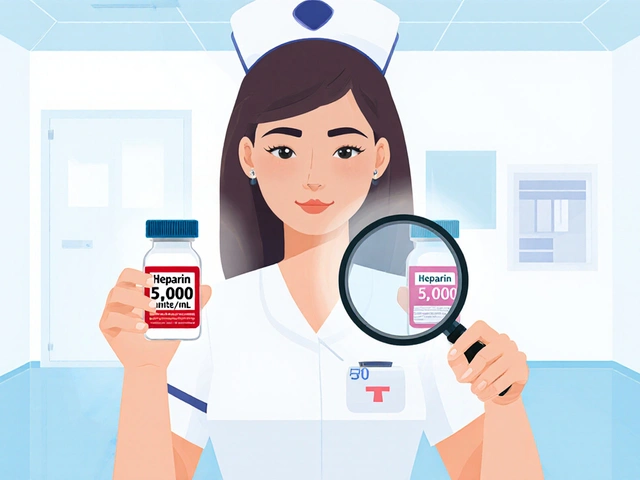Rescue Inhaler Comparison Tool
Find Your Ideal Rescue Inhaler
Answer a few simple questions to see which inhaler best matches your needs.
Choosing the right rescue inhaler can feel like a gamble, especially when every brand promises faster relief and fewer side effects. If you’ve tried a few different devices and are still unsure which one truly fits your breathing pattern, you’re not alone. This guide breaks down the Levolin inhaler and puts it side‑by‑side with the most common alternatives, so you can see exactly where it shines and where other options might serve you better.
What is the Levolin Inhaler?
When you hear “Levolin Inhaler is a levosalbutamol‑based rescue inhaler designed for rapid relief of bronchospasm,” you know you’re looking at a fast‑acting bronchodilator. Levosalbutamol, the active ingredient, belongs to the β2‑agonist class, which relaxes airway smooth muscle within minutes. The device itself is a press‑urized metered‑dose inhaler (pMDI) that delivers a fine mist of medication directly to the lungs, minimizing systemic exposure.
How Levolin Works - The Pharmacology in Plain Language
Levosalbutamol binds selectively to β2‑adrenergic receptors on bronchial smooth muscle. This triggers a cascade that increases cyclic AMP, leading to muscle relaxation and airway dilation. Because the molecule is the R‑enantiomer of salbutamol, it delivers the therapeutic effect with less tachyphylaxis (diminishing response) compared to the racemic mixture. The onset of action is typically 2-5 minutes, with peak bronchodilation around 15 minutes and a duration of 4-6 hours.
Key Criteria for Comparing Rescue Inhalers
Before diving into the side‑by‑side table, it helps to know the metrics that matter most to patients and clinicians:
- Onset of relief: How quickly do you feel your breathing improve?
- Duration of effect: How long does the bronchodilation last?
- Dosing flexibility: Can you adjust the dose for mild vs. severe attacks?
- Device type: pMDI, dry‑powder inhaler (DPI), or nebulizer?
- Side‑effect profile: Tremor, palpitations, or throat irritation?
- Prescription status & cost: Is it over‑the‑counter, and what does it cost per inhaler?

Comparison Table: Levolin and Common Alternatives
| Inhaler | Active Ingredient | Onset (min) | Duration (hrs) | Device Type | Typical Cost (USD) |
|---|---|---|---|---|---|
| Levolin | Levosalbutamol | 2-5 | 4-6 | pMDI | ≈ $30 (200 µg per actuation) |
| Ventolin | Salbutamol | 3-7 | 4-6 | pMDI | ≈ $25 (100 µg) |
| Formoterol Respimat | Formoterol | 1-3 | 12 | Soft mist inhaler | ≈ $45 (12 µg per inhalation) |
| Symbicort | Budesonide / Formoterol | 1-3 | 12 (maintenance) + 4‑6 (relief) | DPI | ≈ $60 (200/6 µg per inhalation) |
| Atrovent | Ipratropium Bromide | 5-10 | 6-8 | pMDI | ≈ $35 (20 µg per actuation) |
Deep Dive into the Alternatives
Salbutamol Inhaler is a racemic β2‑agonist widely marketed as Ventolin. It’s the most familiar rescue inhaler on the market, often available over the counter in many countries. While its onset is slightly slower than levosalbutamol, it’s cost‑effective and supported by decades of clinical data.
Formoterol Inhaler is a long‑acting β2‑agonist (LABA) that also offers a rapid onset, making it a hybrid rescue/maintenance option. Because of its 12‑hour duration, doctors often prescribe it for twice‑daily use rather than for occasional attacks. The soft‑mist delivery can feel gentler on the throat but may require inhalation technique training.
Budesonide/Formoterol Inhaler is a combination inhaler that provides both anti‑inflammatory (budesonide) and bronchodilator (formoterol) actions. It’s primarily a maintenance therapy, but the formoterol component kicks in within minutes, so some patients use it as a rescue dose when their asthma is poorly controlled. The DPI format requires a dry‑powder inhalation technique.
Ipratropium Inhaler is a short‑acting anticholinergic that works by blocking muscarinic receptors, offering a different mechanism from β2‑agonists. It’s especially useful in COPD exacerbations or when patients experience β2‑agonist‑induced tremor. Its onset is slower, so it’s rarely used as a stand‑alone rescue for asthma.
Beyond inhalers, two oral agents often appear in “alternatives” lists:
- Montelukast is a leukotriene receptor antagonist taken once daily to reduce chronic inflammation. It’s not a rescue drug but can lower the frequency of attacks.
- Theophylline is a xanthine bronchodilator with a narrow therapeutic window, used mainly when inhaled therapies fail. Blood level monitoring is required.
When Levolin Is the Right Choice
If you need a pure rescue inhaler that acts fast, costs moderate, and avoids the added steroid load of combination devices, Levolin often edges out the competition. It’s especially handy for:
- Patients who have experienced tachyphylaxis with repeated salbutamol use.
- Individuals who prefer a pMDI over a soft‑mist or DPI, because the technique feels more natural.
- Those seeking a prescription‑only option that still fits within most insurance formularies.
Practical Checklist for Selecting a Rescue Inhaler
- Assess onset speed. If you panic during an attack, a 2‑minute onset (Levolin, Formoterol) beats a 7‑minute onset (some ipratropium).
- Check device compatibility. Do you have a spacer? Do you struggle with coordinating actuation and inhalation? Choose a device that matches your skill.
- Review side‑effects. Tremor, palpitations, and throat irritation vary by β2‑agonist potency.
- Consider cost and coverage. Compare out‑of‑pocket prices; generic salbutamol may be cheaper, but levosalbutamol can be a better value if it reduces rescue frequency.
- Ask about comorbidities. COPD patients might benefit from adding ipratropium; asthma‑only patients usually stick with β2‑agonists.
Common Pitfalls & Pro Tips
Even a great inhaler can underperform if misused. Here are the top mistakes and how to avoid them:
- Not shaking the pMDI. Always shake for 5 seconds before each actuation; otherwise, the dose may be uneven.
- Improper breathing technique. Inhale slowly and deeply, hold the breath for 10 seconds, then exhale gently. This maximizes lung deposition.
- Missing the spacer. Using a spacer with a pMDI can reduce oropharyngeal deposition and improve drug delivery, especially for children.
- Exceeding the recommended dose. More puffs don’t mean faster relief; they can increase side‑effects and desensitize receptors.
- Neglecting regular follow‑ups. Your doctor should review inhaler technique and control status at least twice a year.
Bottom Line
When you line up the numbers, the Levolin inhaler holds its own against the big names. It offers a rapid onset, a respectable duration, and a cost profile that fits most budgets. For pure, quick rescue without the extra steroid or anticholinergic baggage, it’s a solid pick. However, if you need a longer‑acting option, a combination inhaler, or a device that works better with your inhalation style, the alternatives in the table may be a better match. Use the checklist above to match your personal needs with the right product, and always confirm your choice with a healthcare professional.
How quickly does Levolin start working compared to Ventolin?
Levolin (levosalbutamol) typically begins to relieve symptoms within 2‑5 minutes, which is a few minutes faster than the 3‑7 minute onset seen with standard Ventolin (salbutamol).
Can I use Levolin with a spacer?
Yes. Using a spacer with any pMDI, including Levolin, improves drug delivery to the lungs and reduces mouth‑throat irritation, especially for children or people with coordination challenges.
Is Levolin suitable for COPD patients?
Levolin can relieve acute bronchospasm in COPD, but many clinicians add an anticholinergic like ipratropium for a broader effect. Always discuss your specific condition with a pulmonologist.
What are the main side‑effects of levosalbutamol?
Common effects include mild tremor, palpitations, and a dry throat. Because levosalbutamol is the pure R‑enantiomer, these symptoms are generally less pronounced than with racemic salbutamol.
How does the cost of Levolin compare to generic salbutamol?
Levolin runs about $30 per inhaler (200 µg per actuation) in the U.S., while generic salbutamol is often $20‑$25 for a 100 µg inhaler. Insurance coverage can narrow the gap, especially if you qualify for a lower co‑pay.



 Medications
Medications





Catherine Viola
October 19, 2025 AT 12:35It is imperative to recognize that the pharmaceutical industry deliberately obfuscates the distinction between levosalbutamol and its racemic counterparts, thereby shielding profit margins from scrutiny. The molecular chirality of levosalbutamol confers a pharmacodynamic profile that is not merely a marginal improvement, but a strategically engineered advantage. By isolating the R‑enantiomer, manufacturers effectively reduce the incidence of tachyphylaxis, which in turn diminishes the frequency of repeat prescriptions. This reduction in repeat prescriptions directly translates to a decrease in revenue streams from ancillary medications, a fact that is often omitted from corporate disclosures. Moreover, the cost structure of Levolin is calibrated to appear competitive while embedding hidden fees within insurance reimbursement algorithms. The seemingly modest $30 price tag masks a complex web of pharmacy benefit manager rebates that ultimately inflate the overall expenditure for the healthcare system. Clinical trials sponsored by the brand have selectively reported onset times, emphasizing the 2‑minute window while downplaying inter‑patient variability. Such selective reporting fosters a perception of superiority that may not hold true under real‑world conditions. In addition, the device design of the pMDI leverages proprietary propellant technologies, creating a barrier to generic substitution and thus extending market exclusivity. The regulatory pathway for levosalbutamol has been expedited under the auspices of “fast‑acting rescue therapy,” a designation that sidesteps the rigorous comparative effectiveness assessments applied to older agents. Consequently, prescribers are inadvertently guided toward a product whose clinical advantage is, at best, marginal. The strategic placement of Levolin within formularies further entrenches its prevalence, as formulary committees often rely on manufacturer‑submitted dossiers that lack independent verification. While patients may experience a perceived faster relief, the long‑term implications of preferentially using one enantiomer over a racemic mixture remain under‑explored. It is advisable for clinicians to scrutinize the underlying data, question the purported benefits, and consider the broader economic impact on the healthcare infrastructure. Only through diligent inquiry can we mitigate the subtle yet profound influence of commercial interests on therapeutic choices.
sravya rudraraju
October 22, 2025 AT 23:55When evaluating rescue options, one must first appreciate the nuanced interplay between pharmacokinetics and patient adherence, a factor that often determines therapeutic success more than the molecule itself. The onset of bronchodilation is a critical parameter, yet the inhalation technique can either accentuate or diminish that benefit, especially in individuals with limited manual dexterity. Therefore, selecting an inhaler that aligns with a patient’s inhalation pattern-whether they prefer a rapid plume or a soft mist-can significantly improve real‑world outcomes. Additionally, the cost‑effectiveness of a device is not solely defined by the sticker price; insurance formularies, co‑pay structures, and the availability of spacers all contribute to the overall economic burden. A pMDI such as Levolin may appear affordable, but without a compatible spacer, the delivered dose can be suboptimal, leading to increased usage and higher cumulative costs. From a clinical standpoint, the side‑effect profile of levosalbutamol is generally favorable, yet clinicians should remain vigilant for atypical presentations of tremor or palpitations, particularly in patients with pre‑existing cardiac conditions. It is also essential to consider the therapeutic ceiling of short‑acting β2‑agonists, as over‑reliance can mask underlying disease progression that warrants escalation of maintenance therapy. The table provided in the guide offers a concise snapshot, but deeper analysis reveals that the duration of action for Levolin remains comparable to traditional salbutamol, limiting its advantage to the initial minutes of relief. For patients who experience frequent exacerbations, adding an anticholinergic agent such as ipratropium may provide synergistic bronchodilation, a strategy that should be individualized based on spirometric data. Finally, regular follow‑ups to reassess inhaler technique and disease control are indispensable components of chronic respiratory management, ensuring that the chosen rescue inhaler continues to meet the patient’s evolving needs.
Ben Bathgate
October 26, 2025 AT 10:15Honestly, the rapid onset claim feels a bit overhyped; you still need proper technique to feel the difference. Most folks end up just swapping brands without noticing real change.
Ankitpgujjar Poswal
October 29, 2025 AT 21:35Listen, if you’re not getting relief in two minutes, push a second puff-just don’t overdo it. The spacer is a game‑changer; use it and you’ll notice the difference right away.
Bobby Marie
November 2, 2025 AT 08:55Levolin’s price is a bit steep for a rescue inhaler.
ashanti barrett
November 5, 2025 AT 20:15It’s understandable to feel uneasy about trying a newer inhaler, especially when you’ve relied on a familiar brand for years. Rest assured, the safety data for levosalbutamol is robust, and many patients report fewer tremors. If you decide to switch, make sure to have a follow‑up appointment to fine‑tune the dosage.
Leo Chan
November 9, 2025 AT 07:35Great breakdown! For anyone juggling multiple inhalers, remember that consistency in technique can outweigh the marginal speed differences. Keep a spacer handy, and don’t hesitate to ask your pharmacist for a demo. Staying on top of your rescue plan empowers you to manage attacks before they become severe. Keep breathing easy!
jagdish soni
November 12, 2025 AT 18:55One might argue that the very notion of "speed" is a construct, a fleeting illusion crafted by pharmaceutical marketing to seduce the gullible masses the soft mist of Levolin beckons, whispering promises of instantaneous relief whilst the very fabric of pulmonary physiology resists such trivialities, yet the casual observer, enamored by the sleek design, surrenders without probing the underlying biochemistry, thus perpetuating the cycle of consumption that fuels the ever‑hungry beast of industry
Christopher Burczyk
November 16, 2025 AT 06:15From a pharmacological perspective, levosalbutamol’s selective β2‑agonism yields a marginally reduced systemic exposure compared to the racemic mixture, a nuance often overlooked in patient counseling. The device’s metered‑dose consistency ensures each actuation delivers a precise microgram amount, facilitating dose titration. Clinical guidelines still recommend using the lowest effective dose to mitigate tachyphylaxis. It is also prudent to evaluate comorbidities that may amplify side‑effects, such as cardiac arrhythmias. Ultimately, individualized therapy remains the cornerstone of effective asthma management.
Caroline Keller
November 19, 2025 AT 17:35Oh, the tragedy of watching patients flail between inhalers like lost souls searching for salvation-the drama is palpable, the stakes are life‑and‑death, yet the industry whispers sweet nothings about "choice" while pulling the strings behind the curtain! It is a performance, a relentless saga of hope and despair, each puff a solitary act in this grand tragedy.
dennis turcios
November 23, 2025 AT 04:55While the table presents a tidy comparison, real‑world data often reveal variability in patient response that such summaries gloss over. The onset of relief can be affected by inhalation technique, which is frequently suboptimal in routine practice. Moreover, the cost differential may be negligible once insurance negotiations are accounted for. Physicians should therefore assess individual patient needs rather than rely solely on headline figures.
Felix Chan
November 26, 2025 AT 16:15Hey folks, just a quick reminder: keep your inhaler upright, give it a good shake, and breathe in slowly. Those tiny tricks can make a world of difference in how fast you feel relief. Stay positive and keep breathing easy!
Thokchom Imosana
November 30, 2025 AT 03:35There is a hidden agenda behind the promotion of Levolin that most clinicians choose to ignore, a subtle orchestration by unseen entities seeking to steer therapeutic choices toward proprietary enantiomers while marginalizing older, generic formulations. The narrative of "faster onset" is amplified by selectively published data, creating a veneer of superiority that rarely withstands rigorous meta‑analysis. Patients, albeit unwitting, become pawns in a larger scheme where market share supersedes genuine clinical benefit. It is essential to scrutinize the pharmacoeconomic implications, as the apparent cost parity evaporates once one accounts for ancillary expenses such as mandated spacers and follow‑up visits. Moreover, the reliance on a single active ingredient could predispose the asthma population to a monoculture of treatment, increasing the risk of widespread resistance should tolerance develop. By fostering a dependency on levosalbutamol, the pharmaceutical ecosystem subtly nudges prescribers toward a narrow therapeutic corridor, restricting the diversity of options that may better serve individual patient phenotypes. The confluence of regulatory pathways, insurance formularies, and aggressive marketing creates a feedback loop that entrenches Levolin’s position in the market, often at the expense of broader patient autonomy. In light of these considerations, a balanced, evidence‑based approach remains the most prudent path forward.